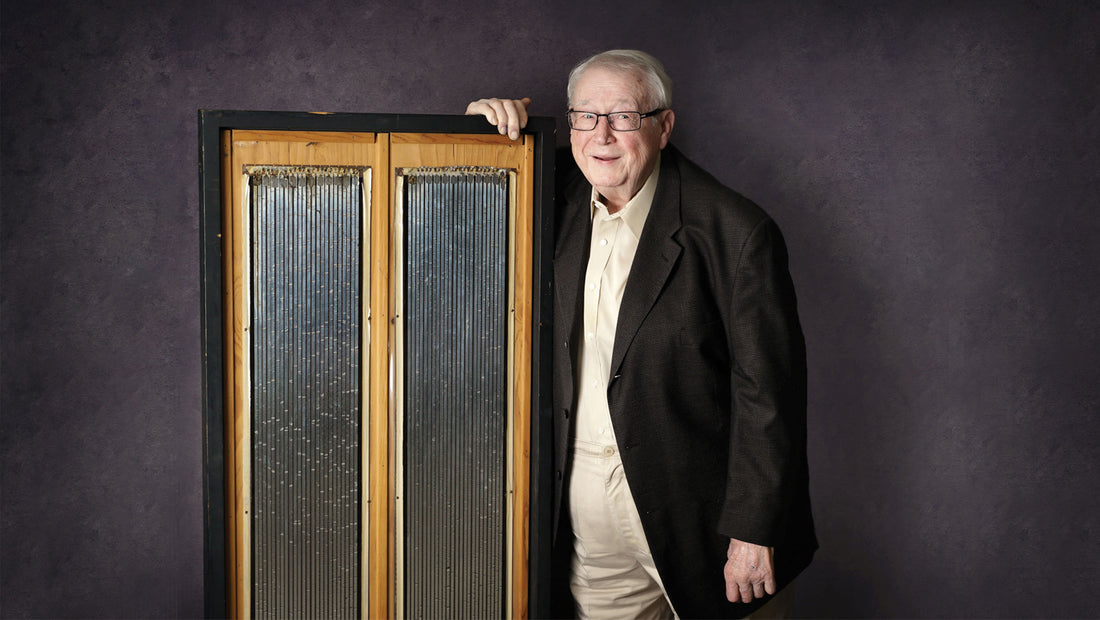I heard the news on January 16 – Jim Winey, the founder of Magnepan, maker of Magneplanar loudspeakers, had passed away at age 89. As I’m sure so many in the industry and so many listeners felt, it was a moment of great personal sadness. You see, Jim Winey and long-time employee Wendell Diller were one of the first people in the audio industry to make me feel welcome when I was just starting out as a writer for The Absolute Sound in 1984.
Before Magnepan, Jim was an engineer at 3M, and also a tinkerer and audiophile. In one of his experiments, he attached conductive material to a thin membrane mounted near magnets. When an audio signal is applied to this kind of planar magnetic driver, the membrane moves back and forth in correspondence to the audio signal, thus creating sound. The results of his experimentation encouraged him to perfect the design and bring it to market as the Timpani 1U in 1971. Through the decades Magnepan has refined their planar magnetic technologies and expanded their product line, from the almost shockingly affordable $995 per pair LRS+ to the flagship 30.7 system ($44,000 per pair) which stands over six feet tall.

Late 1970s Magnaplanar MG-1 loudspeakers. The grille on the right speaker has been removed. Courtesy of Wikimedia Commons/public domain.
The details of when I first met Jim are fuzzy in my brain, but it was probably at my first CES in 1988, in Las Vegas. As an audiophile I was familiar with Magneplanar speakers, having first heard them at a dealer I can’t remember, probably in the 1980s. I may not remember the details, but I sure remember the sound. The transparency, lifelike soundstage, transient attack, and above all, sense of being there with the musicians absolutely astounded me. The experience gave me a lifelong love of planar magnetic and electrostatic flat-panel transducers (as well as enclosure-less dynamic driver designs).
Magnepan used to exhibit with Audio Research and others at the Golden Nugget, and at that 1988 CES they invited the press to an open house that was a must-attend on every reviewer’s calendar. I was excited and a little apprehensive – after all, Harry Pearson had gone on and on about Magneplanars in the pages of TAS and in my mind, Jim Winey and Wendell Diller were larger-than-life figures. How delightful, then, to find out that the three of them were down-to-earth Midwesterners who welcomed me with genuine warmth. They instantly put me at ease and invited me to sit and listen.

Jim Winey in an early Magneplanar ad.
Well, there’s a reason Magneplanar speakers and Audio Research electronics are considered a classic combination, though, both companies being from Minnesota, it made geographic and practical sense that they would partner. The system sounded wonderful, even better than what I’d heard at that dealer that time, and closer to real life than anything I’d heard before.
I spent a good amount of time at that press event simply basking in the sound. Big full-range speaker panels – probably one of the Tympani models – in a large room with plenty of tube power to drive them made for a glorious, expansive sound.
Jim was ever-eager to explain the details behind the speakers, and about speaker design in general. I thought I knew something about planar magnetic drivers and ribbon tweeters until I met Jim, who spent much time with me at that event, and whenever I met him. He was like a proud father bragging about his children when it came to the Maggies. I could feel his genuine affection for music and for his speakers. In fact, he was like the cool uncle you met at family events, talking about and teaching you things that you wouldn’t know about otherwise, and being a mentor.
Over the years I would make it a point to see Jim and check out Magnepan’s latest designs. I lost touch with him and with Wendell after I left The Absolute Sound in the 1990s and became a public relations person, where I’d be chained to our clients’ booths and not able to roam the show floors. A few years ago, I reconnected with Wendell, but somehow never got to speak with Jim again.
With his passing, the industry has lost one of its true founding fathers, and a true gentleman. I will remember him fondly, cueing up records and CDs, then stepping off to the side of those tall, slim panels, and listening along with the people in the room with a knowing smile on his face.

The top-of-the-line MG 30.7 loudspeaker system.
******
Magneplanar Speakers: Different by Design
Located in White Bear Lake, Minnesota since its inception, Magnepan has exclusively manufactured planar magnetic panel loudspeakers. Unlike dynamic drivers that utilize cones, Magneplanar speakers employ electrically conductive wires or foil strips that are bonded to a Mylar sheet. When an audio signal is sent to these planar magnetic drivers, they move back and forth to create sound. The drivers are dipole; that is, they radiate sound to both the front and rear. This creates a spaciousness to the sound that many listeners find extremely pleasing and lifelike.
Many Magneplanar speakers are physically large in order to produce extended bass at higher volumes – planar designs are not as efficient at this task as conventional woofers mounted in enclosures, especially of the bass reflex variety. Magneplanars are relatively inefficient at 86 dB and have a 4-ohm impedance, meaning that it takes something of a robust amplifier with higher power and high current to drive them sufficiently. For Magneplanar aficionados, such considerations are outweighed by their sonic advantages. Over the decades, refinements in materials and production techniques have kept them in the top rank of loudspeakers. Once revolutionary in design, Magneplanar speakers have attained the status of classics, and deservedly so.


